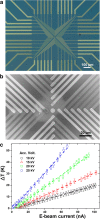Measurement and Evaluation of Local Surface Temperature Induced by Irradiation of Nanoscaled or Microscaled Electron Beams
- PMID: 30671671
- PMCID: PMC6342749
- DOI: 10.1186/s11671-018-2821-x
Measurement and Evaluation of Local Surface Temperature Induced by Irradiation of Nanoscaled or Microscaled Electron Beams
Abstract
Electron beams (e-beams) have been applied as detecting probes and clean energy sources in many applications. In this work, we investigated several approaches for measurement and estimation of the range and distribution of local temperatures on a subject surface under irradiation of nano-microscale e-beams. We showed that a high-intensity e-beam with current density of 105-6 A/cm2 could result in vaporization of solid Si and Au materials in seconds, with a local surface temperature higher than 3000 K. With a lower beam intensity to 103-4 A/cm2, e-beams could introduce local surface temperature in the range of 1000-2000 K shortly, causing local melting in metallic nanowires and Cr, Pt, and Pd thin films, and phase transition in metallic Mg-B films. We demonstrated that thin film thermocouples on a freestanding Si3N4 window were capable of detecting peaked local surface temperatures up to 2000 K and stable, and temperatures in a lower range with a high precision. We discussed the distribution of surface temperatures under e-beams, thermal dissipation of thick substrate, and a small converting ratio from the high kinetic energy of e-beam to the surface heat. The results may offer some clues for novel applications of e-beams.
Keywords: Electron beam; Energy converting; Local temperature; Melting point; Nanoscale thermometry; Scanning electron microscopy; Thin film thermocouple; Transmission electron microscopy; Vaporization.
Conflict of interest statement
Competing Interests
The authors declare that they have no competing interests.
Publisher’s Note
Springer Nature remains neutral with regard to jurisdictional claims in published maps and institutional affiliations.
Figures








Similar articles
-
Micro-thermocouple on nano-membrane: thermometer for nanoscale measurements.Sci Rep. 2018 Apr 20;8(1):6324. doi: 10.1038/s41598-018-24583-w. Sci Rep. 2018. PMID: 29679036 Free PMC article.
-
Self-consistent charging of PMMA thin film induced by a penetrating electron beam in electron microscopy.J Microsc. 2021 May;282(2):175-188. doi: 10.1111/jmi.12992. Epub 2021 Jan 4. J Microsc. 2021. PMID: 33616941
-
Tuning LSPR of Thermal Spike-Induced Shape-Engineered Au Nanoparticles Embedded in Si3N4 Thin-Film Matrix for SERS Applications.ACS Appl Mater Interfaces. 2023 Sep 27;15(38):45426-45440. doi: 10.1021/acsami.3c08834. Epub 2023 Sep 15. ACS Appl Mater Interfaces. 2023. PMID: 37712830
-
Charging effects of SiO2 thin film on Si substrate irradiated by penetrating electron beam.Micron. 2021 Jan;140:102961. doi: 10.1016/j.micron.2020.102961. Epub 2020 Oct 13. Micron. 2021. PMID: 33099205 Review.
-
Fabrication and characterization of nanostructures on insulator substrates by electron-beam-induced deposition.Sci Technol Adv Mater. 2008 Aug 1;9(2):023002. doi: 10.1088/1468-6996/9/2/023002. eCollection 2008 Apr. Sci Technol Adv Mater. 2008. PMID: 27877950 Free PMC article. Review.
Cited by
-
Correction to "Direct Visualization of Crystalline Domains in Carboxylated Nanocellulose Fibers".ACS Omega. 2021 Sep 22;6(39):25842-25844. doi: 10.1021/acsomega.1c04621. eCollection 2021 Oct 5. ACS Omega. 2021. PMID: 34632240 Free PMC article.
-
Electron Beam Induced Enhancement and Suppression of Oxidation in Cu Nanoparticles in Environmental Scanning Transmission Electron Microscopy.ACS Nanosci Au. 2023 Aug 1;3(5):389-397. doi: 10.1021/acsnanoscienceau.3c00018. eCollection 2023 Oct 18. ACS Nanosci Au. 2023. PMID: 37868225 Free PMC article.
References
-
- Babin S. Measurement of resist heating in photomask fabrication. J Vac Sci Technol B. 1997;15:2209–2213. doi: 10.1116/1.589615. - DOI
-
- Babin S, Kahng AB, Măndoiu II, Muddu S. Improving critical dimension accuracy and throughput by subfield scheduling in electron beam mask writing. J Vac Sci Technol B. 2005;23:3094–3100. doi: 10.1116/1.2132330. - DOI
-
- Jugessur A, Yagnyukova M, Aitchison J. Nanofabrication of photonic crystal-based devices using electron beam spot lithography. J Vac Sci Technol B. 2011;29:06FF06. doi: 10.1116/1.3662088. - DOI
-
- Thin-film deposition . Principles and practice. New York: McGraw-hill; 1995.
-
- Dai Q, Kong XD, Feng QR, Yang QQ, Zhang H, Nie RJ, Han L, Ma YW, Wang FR. MgB2 films prepared by rapid annealing method. Physica C. 2012;475:24–27. doi: 10.1016/j.physc.2012.01.014. - DOI
Grants and funding
LinkOut - more resources
Full Text Sources

